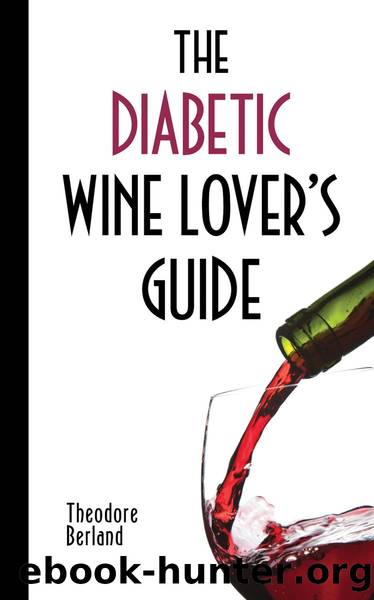The Diabetic Wine Loverâs Guide by Theodore Berland B.S. A.M. FAMWA

Author:Theodore Berland, B.S., A.M., FAMWA
Language: eng
Format: epub
Publisher: Dudley Court Press
Published: 2015-12-15T00:00:00+00:00
Chapter Five
Your Alcohol
Wine is an alcoholic beverage; it contains alcohol.
Table wines range from 7-to-15 percent alcohol. Wine also contains much water and smaller amounts of an amazing number of other chemicals, some of which contribute to wineâs wonderful color and flavor, and many of which bestow health benefits to those who drink it. More about this later.
In this chapter we will examine the science of this ingredient, alcohol, that is so much enjoyed, yet heavily taxed and attacked.
As we explained in the previous chapter, wine is made during the process of fermentation of sugar by yeast from the skin of the grape when it meets the sweet juice inside. Under proper temperatures and absent of oxygen, these friendly micro-organisms convert the grape sugar into alcohol and carbon dioxide (CO2). During the production of most wines, the CO2 is allowed to escape. In the production of sparkling wines, such as champagne, however, this gas is contained so it can escape as bubbles when the bottle is opened and the wine poured.
Alcohol Primer
What follows are some basic facts, some a bit technical, about the chemistry, physics, and biochemistry of alcohols.
To begin with, the alcohol in wine is ethyl alcohol, usually called ethanol.
Ethanol for human consumption is produced by the fermentation of plant biologicalsânot only grapes, but other fruits, such as apples and oranges, as well as vegetables such as corn and potato mashes, and grains such as barley. There are other kinds of yeasts, for other kinds of alcoholic beverages, such as beer, gin, and vodka.
(As an aside: In todayâs agricultural industry, corn and grasses are fermented to produce ethanol that can be used not for drinking, but for motor fuel. Like gasoline, it is volatile and combustible; unlike gasoline, its products of combustion are not noxious.)
Alcohols are among the few substances that can both burn and also be dissolved in water. That makes them ideal fuel for cooking aboard small ships and at camp and elsewhereâand for manufacturing processes. Because alcohols also dissolve oils and greases, they are used in the manufacture of paints, lacquers, solvents, and cleaning products.
Chemistry of Alcohol
All alcohols are composed of hydrogen, oxygen, and carbon. The alcohol molecule is characterized by the OH or hydroxyl group. For instance, the chemical formula for ethanol is CH3CH2OH.
Industrial ethanol is synthesized from ethylene, silica, and phosphoric or tungstic acid. To prevent human consumption and avert taxation, manufacturers âdenatureâ such alcohol, just as they do with rubbing alcohol (isopropyl). This means that they add colors and toxic substances which have unpleasant odors and tastes and cause severe gastric distress and other serious disorders in people foolish enough to ingest such industrial-strength âcocktails.â
Other kinds of alcohol are produced synthetically, not by fermentation, for industrial purposes. Wood alcohol, or methanol, is made by combining hydrogen with carbon monoxide. Other industrial alcohols are synthesized from such fossil fuels as petroleum, natural gas, and coal. All are poisonous.
Ethanol in the Body
Now that you know the chemical nature of wineâs ethanol, letâs see what happens after you swallow a sip of wine at dinner.
Download
This site does not store any files on its server. We only index and link to content provided by other sites. Please contact the content providers to delete copyright contents if any and email us, we'll remove relevant links or contents immediately.
What's Done in Darkness by Kayla Perrin(26593)
The Fifty Shades Trilogy & Grey by E L James(19079)
Shot Through the Heart: DI Grace Fisher 2 by Isabelle Grey(19058)
Shot Through the Heart by Mercy Celeste(18936)
Wolf & Parchment: New Theory Spice & Wolf, Vol. 10 by Isuna Hasekura and Jyuu Ayakura(17112)
Python GUI Applications using PyQt5 : The hands-on guide to build apps with Python by Verdugo Leire(16994)
Peren F. Statistics for Business and Economics...Essential Formulas 3ed 2025 by Unknown(16878)
Wolf & Parchment: New Theory Spice & Wolf, Vol. 03 by Isuna Hasekura and Jyuu Ayakura & Jyuu Ayakura(16825)
Wolf & Parchment: New Theory Spice & Wolf, Vol. 01 by Isuna Hasekura and Jyuu Ayakura & Jyuu Ayakura(16447)
The Subtle Art of Not Giving a F*ck by Mark Manson(14353)
The 3rd Cycle of the Betrayed Series Collection: Extremely Controversial Historical Thrillers (Betrayed Series Boxed set) by McCray Carolyn(14140)
Stepbrother Stories 2 - 21 Taboo Story Collection (Brother Sister Stepbrother Stepsister Taboo Pseudo Incest Family Virgin Creampie Pregnant Forced Pregnancy Breeding) by Roxi Harding(13645)
Scorched Earth by Nick Kyme(12771)
Drei Generationen auf dem Jakobsweg by Stein Pia(10965)
Suna by Ziefle Pia(10889)
Scythe by Neal Shusterman(10338)
The Ultimate Python Exercise Book: 700 Practical Exercises for Beginners with Quiz Questions by Copy(9538)
International Relations from the Global South; Worlds of Difference; First Edition by Arlene B. Tickner & Karen Smith(9522)
D:\Jan\FTP\HOL\Work\Alien Breed - Tower Assault CD32 Alien Breed II - The Horror Continues Manual 1.jpg by PDFCreator(9515)
